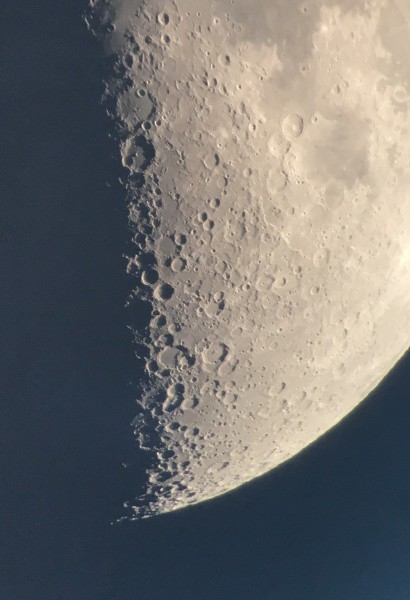2021
March
27
|
Making software look right on a high-DPI display
Many newer computers, including my ThinkPad, have high-DPI displays.
That means their screens have appreciably more than 100 pixels per inch
and are very sharp and crisp, and most of the software looks
great. If some of yours doesn't, read on.
Most computers until recently had about 100 pixels per inch,
such as my previous laptop, with its 17-inch, 900×1600-pixel display.
Software is designed for displays about this size.
The ThinkPad has a 17-inch, 3840×2160 display, giving about 260
pixels per inch.
This is a high-DPI display.
Obviously, if software were to address the pixels of the ThinkPad as if they
were the native pixels of an earlier computer, everything would come out tiny.
Instead, Windows scales it up, and usually gets it right.
In fact, newer software addresses the screen using vector graphics and comes out
very, very sharp. Older software is usually just magnified, and looks less crisp,
but completely normal. Some software is partly one way and partly the other.
Some software goes wrong; part or all of it comes out either very tiny or very blurry.
You can generally fix this by telling Windows to do the scaling a different way.
Here's how I fixed an older version of Photoshop:
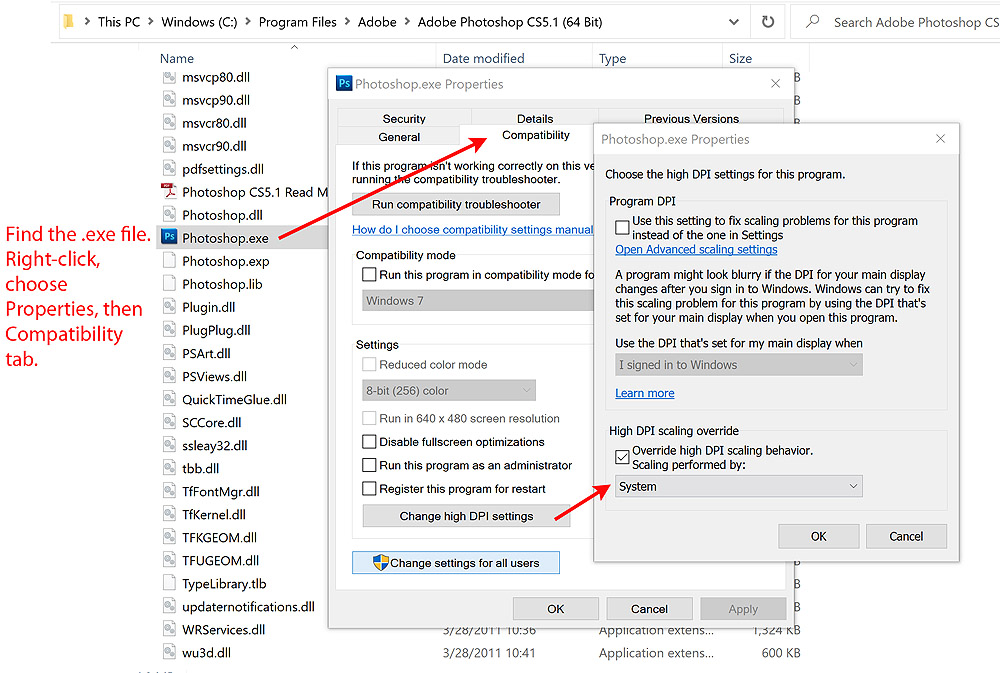
You have to find the executable file, which is usually
somewhere in C:\Program Files.
Then, "System" is usually the right setting, but try all the alternatives.
I had to do this for several pieces of software.
The only one that foiled me was
Virtual Moon Atlas 7.0,
which makes the labels too small no matter what I do.
Fortunately,
Virtual Moon Atlas 6.0 is still available
and works correctly with the "System" setting.
Permanent link to this entry
Getting data to another computer fast
I record my lunar and planetary video images on an old Asus UX32A notebook computer, often
generating 20 GB of data in a single session.
I then need to transfer this to the computer on which I process the images,
which are distilled down to high-resolution still pictures.
And there are several ways to do this. What I've just learned is that some USB flash drives are
a lot faster than others — and that the USB 3 ports on one side of the computer are
appreciably faster than the one on the other side!
Here are speeds I measured:
| Copying from the internal SSD drive to itself |
175 MB/s |
| Speed at which the software records video files |
64 MB/s |
| Fast USB flash drive on right-side USB port |
53 MB/s |
| Fast USB flash drive on left-side USB port |
29 MB/s |
| Fast (class 3) SSD card in SSD card reader |
16 MB/s |
| Older, low-cost USB flash drives |
< 5 MB/s |
| Wi-Fi transfer to another computer on the network |
8 MB/s |
Bear in mind that these speeds are from a vintage-2013 computer;
back then, I was delighted to get USB 3 at all.
My new ThinkPad can write on the SSD card at 70 MB/s, but its speed
writing to the new USB flash drive is the same as that of the old Asus.
Lessons learned:
- A fast USB flash drive is a good investment.
The one that is serving me so well is linked below.
- Some USB 3 ports can be faster than others
on the same computer — try them all!
- With newer computers, SSD can be faster than USB flash. Try it.
- Wi-Fi is very slow compared to any kind of removable flash media.
- The best USB flash drive is probably not quite
fast enough to record the video directly.
But I'm going to try it.
If it works, it will save me a step.
Here's the one that is working so well for me.
Click on it for the Amazon link.
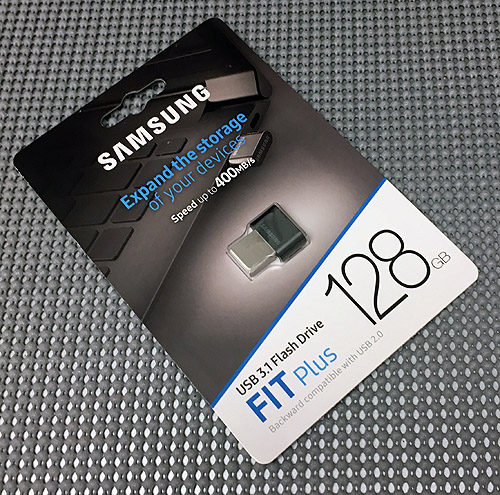
Permanent link to this entry
Short note
This ThinkPad has a color-calibrated screen, and with that in mind, I've adjusted the
Daily Notebook's background color to be a bit bluer.
This is retroactive to other recent months that use the same style sheet.
Permanent link to this entry


|
2021
March
23
|
Dew-heater controller
Yesterday I finished an electronic project that had been sitting on my workbench
since mid-2006. Back then, I went to the late lamented Ack Radio, Inc., in Atlanta,
and bought, among other things, an enclosure and a small potentiometer and knob.
The purpose was to build a new dew-heater controller for my telescope, to replace
a temporary one built in 2001 (which I ended up using for 20 years).
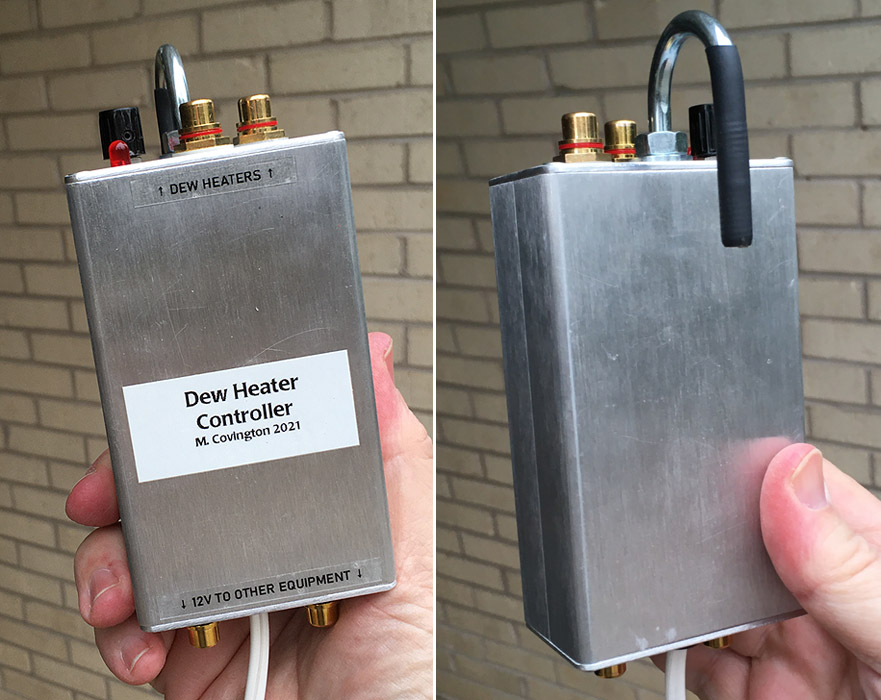
What are dew heaters? Weak heating elements wrapped around the front lenses of telescopes
to keep dew from forming. Left to itself, the lens radiates heat and actually gets
colder than the surrounding air, thus attracting dew. With a couple of watts of heat,
the lens can be kept at the same temperature as the air, eliminating the dew problem
and actually making the view steadier by reducing air turbulence.
The amount of heat needs to be variable, hence the need for a controller.
This one uses pulse-width modulation at about 450 Hz.

Changes made later: R4 is 22k, not 2.2k (to keep the LED from
being too bright during observing sessions); a 7.5-amp fuse was added to the circuit
in the 12-volt input, before any outputs.
This is the same circuit as I used in 2001 except for a better MOSFET; the one I used
is on a heat sink but apparently doesn't need it, because with an "on" resistance
of 0.16 ohm, it dissipates only 2/3 of a watt when carrying 2 amps continuously.

It's in a clamshell-type enclosure made of extruded aluminum;
the circuit board fits into a slot and
is held in place with dabs of contact cement (which is rubbery and can be peeled
off if I ever need to repair the board).
The big hook, for hanging the unit on an eyepiece rack, is a U-bolt with
heat-shrink tubing over the threads on one side.
Permanent link to this entry
Building with stripboard
This construction project in fact used up part of the last sheet of stripboard
remaining from about a dozen that I bought from a bargain counter in Germany
in 1987. The exact same sheet is still made — it is or was a European standard —
and one example is the BusBoard ST3U
available from Amazon and other suppliers.
Stripboard has holes 0.1 inch apart (to match IC pins),
connected by copper strips, which can be cut by twirling a 3/16-inch
drill bit in one of the holes.
Here are top and bottom views of my circuit board.
You can see one place where I cut one of the copper strips in the wrong
place and had to bridge it with wire.
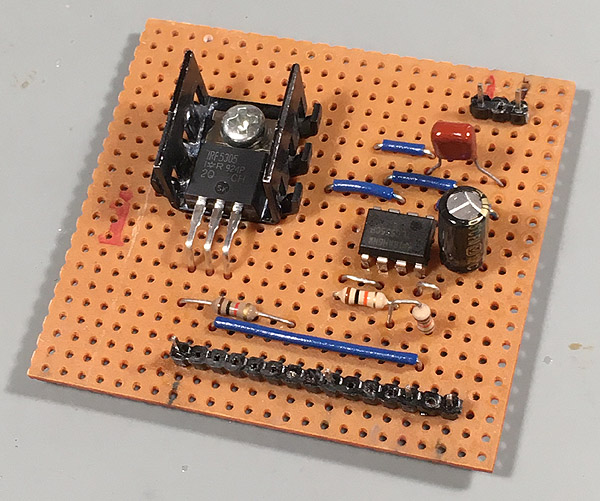
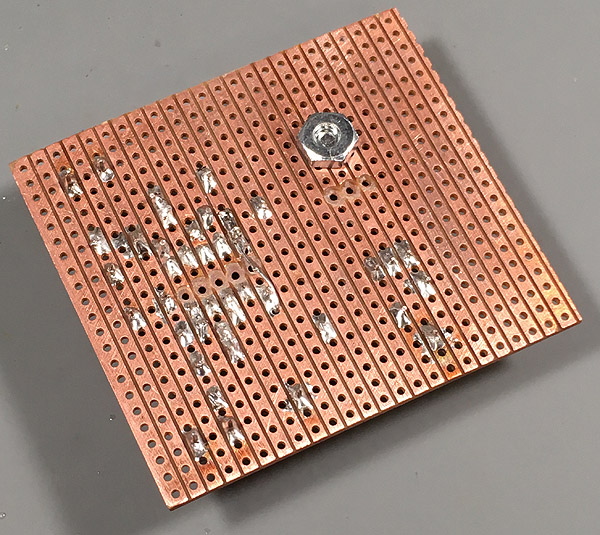
Incidentally, this was done entirely with lead-free solder (Kester K100LD) and came
out beautifully. Two hints: In modern times we put a little flux on almost everything
before soldering it (I used a Kester flux pen), and lead-free solder only comes out
shiny if there is absolutely no lead-based solder mixed with it.
On the top, you can see something unusual — row headers with pins missing
(to make it easier to attach larger wires). Where do I get these?
Simple. I attach the row header to the board, soldering only the pins that
are going to stay, and then remove the other pins by heating them with a soldering iron
to loosen the plastic so they can be pulled out.
Getting back to stripboard: It remains my preferred type of prototype board even though
pad-per-hole board is nowadays much more common.
As the name implies, pad-per-hole board has a small copper pad around each hole, not
connecting to any other hole.
You have to lay down wires to make connections.
This can come out more compact, but it makes it harder to replace components —
you can't just pull them out of their holes, you also have to deal with whatever is
attached below deck.
You can make components replaceable by looping wires around the holes
they will occupy, as demonstrated
here.
Prototyping with pad-per-hole board is described and illustrated
here.
I've accumulated so much pad-per-hole material over the years that I should try to get
used to it. I think it works best with digital ICs that have a lot of pins but leave
many of the pins unconnected.
Permanent link to this entry


|
2021
March
20
|
Short notes
I haven't actually stopped writing in the Daily Notebook, but we've all been busy. Here are some
short notes.
Fourth wave coming? Both in Georgia and nationally, the rapid decline of COVID infections has
stopped or even reversed. This may just be an irregularity in reporting, but on the other hand it
may be the start of a fourth wave. Friends, now is not the time to party like it's 2019.
(Official Georgia data below. Note the recent upturn, a false upturn in February, and a real
upturn in October.)
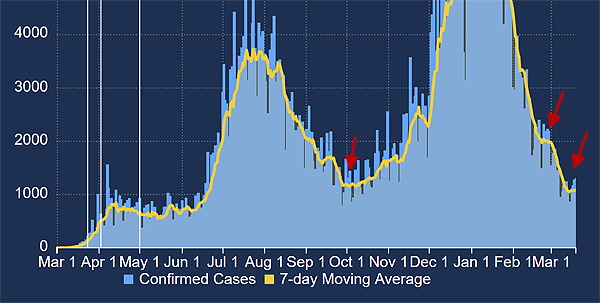
[Update: One theory is that the virus has mutated and is more contagious.]
There are still some grounds for cautious optimism. The United States is finally vaccinating a
substantial number of people. And if you look at the date of disease onset rather than of reporting,
it's not so evident that we're having an upturn; maybe we're not. We'll see.
Vaccinated: Melody, Sharon, and I finally got the first dose of the Pfizer vaccine two
days ago. For me, it produced mild cold-like symptoms and some soreness in my arm.
Death to the viruses! Second dose is April 8.
New laptop: One of the many things going on is that I'm moving into a new Lenovo Thinkpad P17.
This is a very generously configured machine with an 8-core, dual-threaded CPU.
The idea is for it to be my main computing engine, even to the point that I may remote into it
from my desktop when I want the comfort of sitting at a big screen.
Its keyboard and screen are much more comfortable to use than on cheaper laptops, even Lenovo.
Permanent link to this entry


|
2021
March
11
|
One year in
March 11, 2010, was the "last normal day" for FormFree, and the last time I worked in their
Milledge Avenue office. A co-worker suggested that some of us who normally worked at home
should come in, and I joined them.
That was the day the WHO declared the pandemic, and that evening, a pro basketball game was
suddenly cancelled, followed by cancellations of almost all public events in the next few days.
Today, there are signs of hope. I'm cautious. Already I've prematurely expressed hope upon seeing
the downturns after two waves, but they were followed by a much more deadly third wave.
The good news is that Georgia's spread rate (Rt) is estimated at 0.75, the lowest it has
ever been, and if we can keep it that low, in a few weeks COVID-19 will be scarce.
But will we? Do you stop fighting a fire when it's 90% out?
No, of course — you press on and kill it dead.
If my fellow Americans will do that, we can get rid of COVID.
Or we can make it flare back up.
Your choice.
Georgia data from
https://dph.georgia.gov/covid-19-daily-status-report:
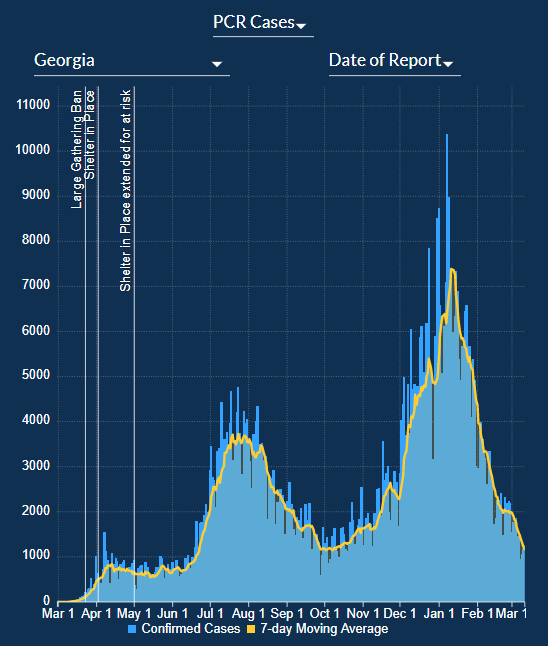
Analysis and forecast from
https://epiforecasts.io/covid/posts/subnational/united-states/georgia/:
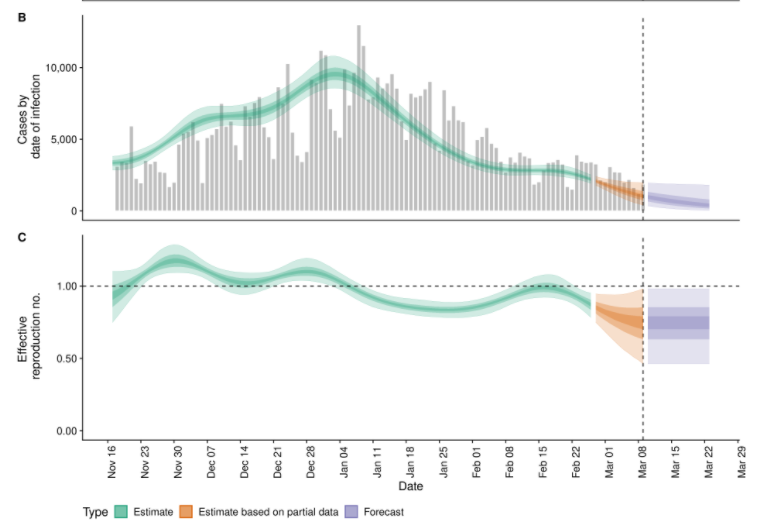
National data are similar to Georgia's.
Why did it drop? Several possibilities:
- Vaccines seem to be doing more good than anyone expected.
They are targeted to the most vulnerable people.
- The epidemic may be "burning itself out" like a fire running out of fuel.
Sadly, a lot of the people who were going to die of COVID have probably already done so.
And a lot of other people have had COVID (possibly without even knowing it) and come
out partly immune.
- There may also be some pre-existing immunity due to other viruses and vaccines that
people have had. This may also be why COVID hasn't devastated Africa.
Meanwhile we are all eagerly awaiting vaccination. My age group becomes eligible
on Monday. If I were two years older, I could have already gotten it.
This is perhaps the last time in my life that I will have been too young for something
that I want to do.
Permanent link to this entry


|
2021
March
10
|
Do you always have a right to your own opinion?
Adapted from a well-received Facebook posting.
Do you always have a right to your own opinion?
Actually, no.
If you're standing in the middle of the road and cars are coming, you don't have the
"right" to the "opinion" that they're not. They'll hit you even if you choose not to believe in them.
That's because the oncoming cars are a matter of fact, not opinion.
There is no real uncertainty about them. Those cars are there.
If someone believes they're not, that is not an opinion; it is an error.
An opinion is an estimate of the facts, which we use when the facts are not completely known.
Just like estimates of my height or the value of my house,
opinions aren't worth much unless they are based on the
best information and reasoning that you can get.
I have gotten tired of people "having a right to an opinion" that COVID isn't real, or the media are all lies,
or the medical journals are all fake, or the earth is flat, or the sky is full of pink elephants.
Some things are genuinely uncertain, and that is where opinions rightfully come in.
The opinions of knowledgeable people are valuable, even if they don't all agree.
Even if we can't get a final answer, we can at least rule out some possibilities,
and say that some things are more likely to be true than others, and figure out what
to investigate further.
But when people choose to believe and say something that they know (or ought to know) is false,
that is not an opinion. It is not even a mistake. It is worse — a lie told to oneself.
Also — and this is a hard thing to say — I am sad, but have to put my foot down about something:
There is a level of foolishness I don't tolerate in my circle of friends or Facebook friends list.
If you give people false information that puts them in harm's way, you are not welcome.
I am very sad to have lost two friends whom I had known for decades.
They went off the deep end into conspiracy theories, and while I hope and pray
they will come to their senses, in the meantime I can't let them annoy or mislead my other friends.
There are many things about which well-informed experts disagree.
For example, it's genuinely uncertain whether lockdowns were the best way to stop the early expansion of COVID.
There's genuine controversy about what the minimum wage should be. And so on.
On issues like these, I gladly hear all sides.
But everybody who knows anything about COVID knows that it is a deadly disease,
and that it has killed a lot of people, and that the vaccine is safe and effective,
and the reporting in medical journals is, by and large, honest.
Like the cars in my first example, these are facts, not matters of opinion.
Saying something else doesn't change them.
If you deliberately make yourself ignorant — by living in a fantasy world and listening only to extremists —
and then tell people "not to live in fear" and not to wear masks or get vaccines,
you are on the same level as if you were telling people to walk in front of oncoming cars.
You are putting other people in danger, and I can't tolerate it.
Lesser forms of foolishness may not put people in danger, but they waste time and create confusion.
I care about what's true in the real world, not what ignorant people make up in their own minds,
or what gullible people swallow from propagandists and quacks.
Of course you have a right to form your own opinions.
That means nobody can compel you to hold a particular opinion.
Even if they try, they can't, because forming an opinion is an act within your own mind.
It does not mean that you have no responsibilities when forming an opinion,
or that any opinion you might choose is as good as any other.
If you are not a fool, you will want your estimates of the truth to be as
close to the real truth as you can get them.
That's what estimates are for.
I want to thank several Facebook readers who brought up important points and
suggested improvements to this explanation. It was well received.
I may have put something into words that many people did not quite know
how to express.
Permanent link to this entry


|
2021
March
6
|
Astronomy 51 years ago and a historic Atlanta sign
Here's a page from my astronomy notebook, 1970. That was almost three months
after my Criterion RV-6 arrived, and I was using it avidly to view Saturn.
Standard practice was to make drawings, since no good way of photographing
planets from earth had been invented (there was nothing like modern digital video
imaging). So here's one observation:
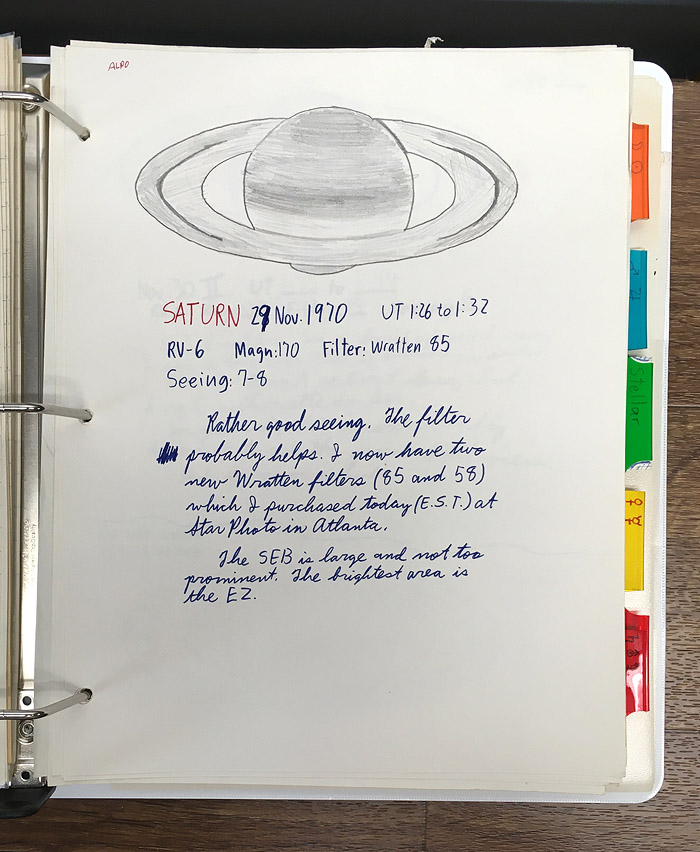
On that day (Saturday, Nov. 28, 1970; Nov. 29 GMT) I had been in Atlanta
visiting cousins and had made a very interesting visit to Star Photo, a major camera store
at the intersection of Ponce De Leon and Argonne Avenue.
Then we drove home to Valdosta and I viewed Saturn.
Star Photo was diagonally opposite the historic Krispy Kreme doughnut shop that just
recently burned down and is being rebuilt.
Interestingly, the giant Kodak sign from Star Photo is still there
and there is a move to designate it a historic landmark
(see AJC coverage).
To see a picture of the building itself some years ago,
click here.
Permanent link to this entry
Another photo for art's sake

This isn't the definitive treatment of this tree; I'm going to try again.
It has been catching my eye because parts of it are lighter than the sky
background, and parts are darker.
Permanent link to this entry


|
2021
March
1
|
Photography for art's sake
I used to attempt art photography nearly every day. I've been away from it most of
the time for several years but have decided to resume trying. So here's a picture I took
in a downtown Athens alley the other day:

Copyright 2021 Michael A. Covington
This and all photographs in the Daily Notebook are covered by copyright.
Many contain hidden copyright information. Please ask permission before copying.
iPhone SE, postprocessed in Photoshop.
Permanent link to this entry
A one-hour vacation
As a post-Valentine's Day resolution, Melody and I have started taking short rambles
together almost every day, exploring the area around Athens and occasionally finding
something picturesque. The other day we went to the Elder Mill Covered Bridge in
nearby Watkinsville, and both of us got some memorable pictures. Here's mine:

Copyright 2021 Michael A. Covington
Here's a more conventional view of the bridge and of the sign describing it.


Permanent link to this entry
University in time of pestilence
I can't totally do without the University of Georgia's libraries, and yesterday (Feb. 28)
I made a short expedition to the Science Library to see if, in fact, I can comfortably
read there while wearing a COVID mask. The answer: it can be done but isn't pleasant.
To control fogging of my glasses, I need a mask with a long wire above the nose, carefully
bent to the right shape.
The University is open but requires masks indoors. The biggest COVID precaution is one
that may become a permanent part of our culture: avoid needlessly crowding close to strangers.
So the students are much more spread out than usual. This is feasible because about two
thirds of them aren't there.
As you can see, they've put a mask on Godwin (a notorious statue that represents God as seen
from one side, Darwin from the other, and from the front, and old man with an eye problem).
And there are stern warnings at entrances to buildings.

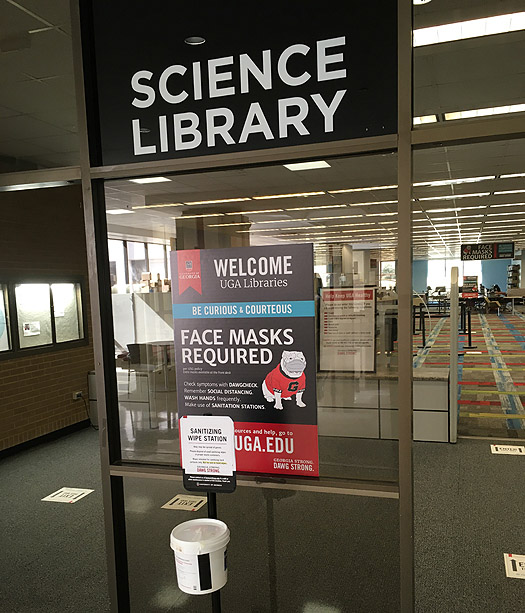
I spent some time looking at an interesting book,
Efron
and Hastie's Computer Age Statistical Inference,
and checked it out.
Permanent link to this entry


|
|
|
This is a private web page,
not hosted or sponsored by the University of Georgia.
Copyright 2021 Michael A. Covington.
Caching by search engines is permitted.
To go to the latest entry every day, bookmark
http://www.covingtoninnovations.com/michael/blog/Default.asp
and if you get the previous month, tell your browser to refresh.
Portrait at top of page by Sharon Covington.
This web site has never collected personal information
and is not affected by GDPR.
Google Ads may use cookies to manage the rotation of ads,
but those cookies are not made available to Covington Innovations.
No personal information is collected or stored by Covington Innovations, and never has been.
This web site is based and served entirely in the United States.
In compliance with U.S. FTC guidelines,
I am glad to point out that unless explicitly
indicated, I do not receive substantial payments, free merchandise, or other remuneration
for reviewing or mentioning products on this web site.
Any remuneration valued at more than about $10 will always be mentioned here,
and in any case my writing about products and dealers is always truthful.
Reviewed
products are usually things I purchased for my own use, or occasionally items
lent to me briefly by manufacturers and described as such.
I am no longer an Amazon Associate, and links to Amazon
no longer pay me a commission for purchases,
even if they still have my code in them.
|
|











